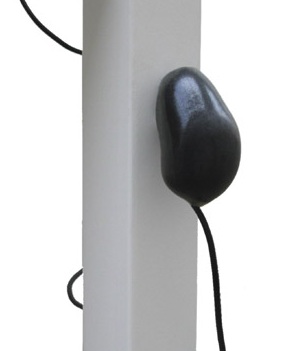 By David Ponce
By David Ponce
The parasite charger, from Swedish design firm BRDA, was conceived quite some time ago, but damn if it ain’t an idea still worth talking about today. It’s a simple charger, much like the ones that you use to charge all your electronics, excepts it’s covered in a silicone-like material and is purposefully designed to look like a parasite. The reason that it’s covered in silicone is that as long as it’s plugged into the wall, a mechanism inside pulsates, giving the impression that the device is alive, and “feeding” on your electrical bill. Its disturbing kind of creepiness is really to remind you not to consume as much energy, and that chargers should be disconnected when the charging is done. At least, that’s what the designers had in mind.
What we’d like to know is if charger do in fact consume energy when they are not connected to their respective devices. If an electric loop is not closed, will current still flow? We think not, but the idea is still very cool. Unfortunately, it doesn’t seem as though this product ever went past the concept/prototype stage, and as it’s been some time since its design, it probably never will be available for purchase.
[ BRDA Home ] VIA [ UberReview ]



Usually I don’t leave my chargers plugged in, but when I do, I have the impression that they feel warm. That would indicate that they do consume energy, even though they’re not charging.
Does anyone else have more experience with this matter?
Yes, a charger will consume energy even if you’re not charging anything with it, but it’s not much. The question is if the saving in energy you get from disconnecting the charger is larger than the energy consumed to make the charger pulsate when in use?
First off, clever (if a bit useless) product. As for the purported issue; Ugh. I’m so sick of this debate. Here’s the deal folks. Many (but not all!) wall-warts will consume a very small amount of electricity if left plugged in while not in use. If electircity is used, and the power supply is well designed, it is only using power to light an “I’m on!” LED – which uses hardly any power. There are plenty out there that *don’t* comsume power while plugged in – and there are many that do in fact cosuem power, albeit tiny, tiny amounts.. It all depends on the design and purpose of the charger. It’s important to understand the history of this issue. It seems to have started with several worry-mongering news programs “exposing” the wasted electricity in your home and falsely blaming wall-warts for the problem when in fact, the wall-warts had almost nothing to do with it. In fact, the problem is due to devices that *seem* powered off and in standby mode to the unsuspecting consumer, while in reality they are pulling a small amount of power while in their standby modes. This can, but doesn’t necessarily include desktop printers, game consoles, LCD/Plasma displays, stereo systems and the like.
In summation, it’s the devices – not the chargers!
Of course, if everyone unplugged all wall-warts when not in use, some power would be saved. Not a great amount, and certainly not an amount worthy of all the energy one would expend just trying to get this semi-misleading message out to everyone.
A charger typically consumes less than 0.03 W while it is not charging anything.
If powered continuously for a year, then it consumes 1/4 of a kilowatt-hour (kWH). The electric company charges you about 10 cents per kWH, so you’ll pay about 2.6 cents per charger per year.
The reason why people are making an issue of it (and other still-powered-when-off devices like DVD players) is that if each house has 10 devices like this plugged in at the same time, and there are a million homes thus outfitted in the US, then we’re wasting, as a nation, over 1/4 million dollars in electricity.
Which is a collective drop in the bucket, and quite frankly not worth caring about. More power is lost in the distribution and transmission lines than in chargers and similar devices.
And, quite frankly, to reduce that by 90% the charger and other devices will cost several dollars more in parts, which would completely swamp any electrical savings over decades worth of use.
-Adam